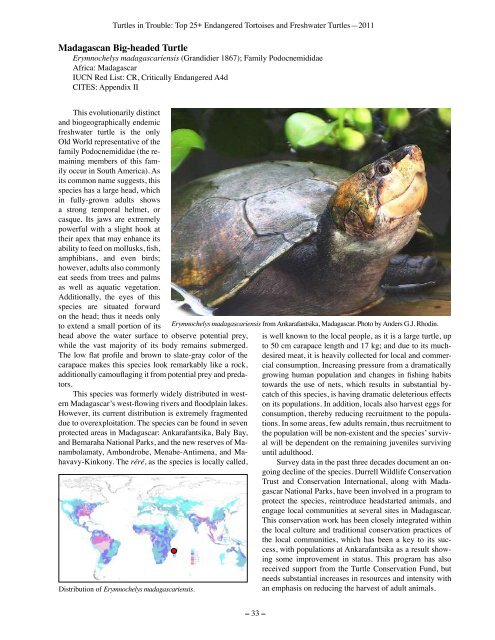Turtles in Trouble: The World's 25+ Most Endangered - Wildlife ...
Turtles in Trouble: The World's 25+ Most Endangered - Wildlife ...
Turtles in Trouble: The World's 25+ Most Endangered - Wildlife ...
- No tags were found...
You also want an ePaper? Increase the reach of your titles
YUMPU automatically turns print PDFs into web optimized ePapers that Google loves.
<strong>Turtles</strong> <strong>in</strong> <strong>Trouble</strong>: Top <strong>25+</strong> <strong>Endangered</strong> Tortoises and Freshwater <strong>Turtles</strong>—2011Madagascan Big-headed TurtleErymnochelys madagascariensis (Grandidier 1867); Family PodocnemididaeAfrica: MadagascarIUCN Red List: CR, Critically <strong>Endangered</strong> A4dCITES: Appendix IIThis evolutionarily dist<strong>in</strong>ctand biogeographically endemicfreshwater turtle is the onlyOld World representative of thefamily Podocnemididae (the rema<strong>in</strong><strong>in</strong>gmembers of this familyoccur <strong>in</strong> South America). Asits common name suggests, thisspecies has a large head, which<strong>in</strong> fully-grown adults showsa strong temporal helmet, orcasque. Its jaws are extremelypowerful with a slight hook attheir apex that may enhance itsability to feed on mollusks, fish,amphibians, and even birds;however, adults also commonlyeat seeds from trees and palmsas well as aquatic vegetation.Additionally, the eyes of thisspecies are situated forwardon the head; thus it needs onlyto extend a small portion of itshead above the water surface to observe potential prey,while the vast majority of its body rema<strong>in</strong>s submerged.<strong>The</strong> low flat profile and brown to slate-gray color of thecarapace makes this species look remarkably like a rock,additionally camouflag<strong>in</strong>g it from potential prey and predators.This species was formerly widely distributed <strong>in</strong> westernMadagascar’s west-flow<strong>in</strong>g rivers and floodpla<strong>in</strong> lakes.However, its current distribution is extremely fragmenteddue to overexploitation. <strong>The</strong> species can be found <strong>in</strong> sevenprotected areas <strong>in</strong> Madagascar: Ankarafantsika, Baly Bay,and Bemaraha National Parks, and the new reserves of Manambolamaty,Ambondrobe, Menabe-Antimena, and Mahavavy-K<strong>in</strong>kony.<strong>The</strong> réré, as the species is locally called,Distribution of Erymnochelys madagascariensis.Erymnochelys madagascariensis from Ankarafantsika, Madagascar. Photo by Anders G.J. Rhod<strong>in</strong>.is well known to the local people, as it is a large turtle, upto 50 cm carapace length and 17 kg; and due to its muchdesiredmeat, it is heavily collected for local and commercialconsumption. Increas<strong>in</strong>g pressure from a dramaticallygrow<strong>in</strong>g human population and changes <strong>in</strong> fish<strong>in</strong>g habitstowards the use of nets, which results <strong>in</strong> substantial bycatchof this species, is hav<strong>in</strong>g dramatic deleterious effectson its populations. In addition, locals also harvest eggs forconsumption, thereby reduc<strong>in</strong>g recruitment to the populations.In some areas, few adults rema<strong>in</strong>, thus recruitment tothe population will be non-existent and the species’ survivalwill be dependent on the rema<strong>in</strong><strong>in</strong>g juveniles surviv<strong>in</strong>guntil adulthood.Survey data <strong>in</strong> the past three decades document an ongo<strong>in</strong>gdecl<strong>in</strong>e of the species. Durrell <strong>Wildlife</strong> ConservationTrust and Conservation International, along with MadagascarNational Parks, have been <strong>in</strong>volved <strong>in</strong> a program toprotect the species, re<strong>in</strong>troduce headstarted animals, andengage local communities at several sites <strong>in</strong> Madagascar.This conservation work has been closely <strong>in</strong>tegrated with<strong>in</strong>the local culture and traditional conservation practices ofthe local communities, which has been a key to its success,with populations at Ankarafantsika as a result show<strong>in</strong>gsome improvement <strong>in</strong> status. This program has alsoreceived support from the Turtle Conservation Fund, butneeds substantial <strong>in</strong>creases <strong>in</strong> resources and <strong>in</strong>tensity withan emphasis on reduc<strong>in</strong>g the harvest of adult animals.– 33 –







![RaLand / SeaScape [PDF] - Wildlife Conservation Society](https://img.yumpu.com/49974326/1/190x245/raland-seascape-pdf-wildlife-conservation-society.jpg?quality=85)








